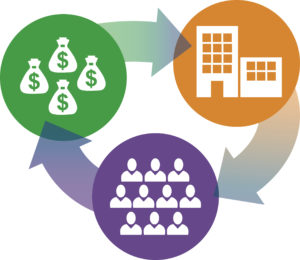For evidence of the Local Economic Development Act (LEDA)’s power to stimulate the state’s entrepreneurial ecosystem, New Mexico residents need look no further than the massive industrial building at 2600 Camino Entrada in Santa Fe.
The former home of CleanAIR Systems and Caterpillar Inc. is now the world headquarters for Meow Wolf Inc., a leader in the vibrant “experience economy” that expects to employ as many as 360 highly skilled workers over the next five years. Its genesis was a City of Santa Fe-backed LEDA loan and grant package that enabled the original owners to capitalize on their company’s rapid growth.
Infrastructure improvements like this building are what the proponents of LEDA envisioned 25 years ago when the law was passed: Allowing local governments to invest taxpayer dollars in promising private-sector businesses can bring jobs, skills training and permanent physical assets to New Mexico communities.
The state has sharpened this economic development tool over the years to protect the public interest. A “clawback” provision ensures public grants are reimbursed if a company leaves the state or sells out earlier than promised. Other provisions require substantial contributions from private investors and a liquid security instrument — such as a mortgage, lien or CD — that government investors can collect if a project fails.
Object Lesson
In 2006, Santa Fe entered into a project participation agreement with Louise and Michael Roach 13 years after the couple launched CleanAIR Systems to manufacture environmentally friendly emission-control products for diesel, gasoline and propane engines. At the time, the company was growing faster than its owners’ financial resources could support.
The Roaches received $300,000 in LEDA funds to build an office and laboratory so their company could make the most of its growing business with Caterpillar, a maker of large tractors and earth-moving equipment. A third of the money was a loan, and $200,000 was a grant the company was required to repay if it left Santa Fe before 2016 or failed to create 50 high-wage jobs. CleanAIR Systems also was required to invest a minimum of $900,000 in private funds.
In 2010, Caterpillar purchased the business, spending $10.4 million to double the facility’s size to 52,000 square feet and gradually beefing up the local workforce to 175 people. In turn, the Roaches repaid the City’s loan with interest for a total of $111,753 and paid back the grant.
Caterpillar ended production at the Santa Fe site in 2016 to consolidate its operations in Illinois. According to Juan Torres, who worked on the CleanAIR Systems LEDA project and is now finance director at the New Mexico Economic Development Department, some of the workers accepted Caterpillar’s offer to transfer to other company facilities, and most of the 50 remaining workers were hired by New Mexico-based tech companies.
Caterpillar also left behind the multi-million-dollar property with parking for 100 and an energy-efficient building containing two bridge cranes capable of lifting 15 and 20 tons, respectively.
Creative Hub
Meow Wolf had considered leaving Santa Fe to pursue expansion possibilities in other cities. That changed when its corporate leaders realized that the Camino Entrada facility could house Meow Wolf’s many creative projects, including research, development and manufacture of exhibits for export to regional and national markets. The company expects to create career paths for workers in fabrication, technology, digital media and other creative professions.
Fabian Trujillo, manager of the City of Santa Fe Office of Business Empowerment, said the original LEDA investment paid off the way it was meant to: with improved infrastructure and high-wage jobs. “Even though there’s a business cycle and businesses do leave,” he said, “what remains are community assets.”
Download 541_Return on LEDA Investment Enriches NM Economy PDF

